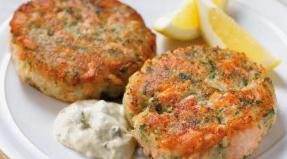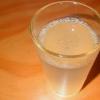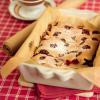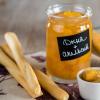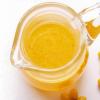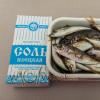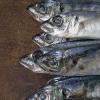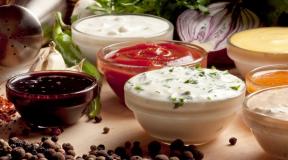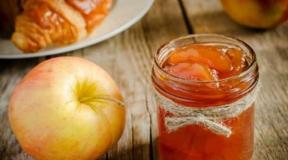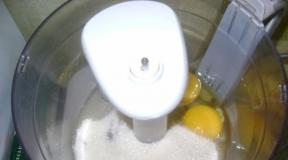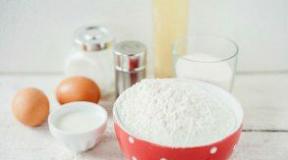Food concentrates. Bacterial concentrate production technology
Specialized information
The main task of the technology for the production of bacterial preparations based on living microorganisms is to ensure such conditions for the production and processing of microbial mass, in which finished products the maximum number of viable cells would be preserved and their useful properties would not be lost.
Depending on the method of canning, there are liquid, frozen and dry bacterial preparations.
See also:
DRY PREPARATIONS. The advantage of dry preparations ("Bifiform", "Linex", "Bactisubtil", etc.) should be considered that the bacteria are in a state of hibernation, as it were. Therefore, they are not so sensitive to temperature changes, they are easier to store. However, in the case of using dry preparations or dry starter cultures of direct application, it is not always possible to talk about obtaining an effective food product, since most strains of lactic acid bacteria during drying significantly change their activity, being in deep anabiosis and restore it only after 3-5 divisions after entering a favorable environment for reproduction. They need about (8-10) hours to transition to an active physiological state, but by this time most of them may already be naturally eliminated from the intestines. In order for at least some part of bacteria to be fixed in the intestine, their concentration in dry preparations should be no less than 10 10-12 live bacteria in 1 gram of dry powder. It is practically impossible to obtain such a high concentration of living bacteria under conditions of spray drying or lyophilization, since 10-25% of the populations of bacteria - probiotics die, and bacteria that have retained their viability sharply reduce their proliferative activity, as a result of which the bulk of bacteria - probiotics in their destination passes through the intestines of humans and animals in transit, providing only a minimal therapeutic and prophylactic effect and not showing the ability to colonize (populate) this ecological niche. The disadvantage is also the high cost of production of dry concentrates due to the fact that the equipment for drying (lyophilization), located in the technological chain of concentrate production, is so expensive that not every enterprise can afford to buy it.
LIQUID PROBIOTICS. Unlike dry probiotics, bacteria are constantly active in liquid probiotics. The main advantage of liquid probiotics is that the bacteria in them are in a living, biologically active form. They have their beneficial effect immediately - immediately after taking the drug, which distinguishes liquid probiotics from similar dry preparations.
In addition to living bacteria, liquid probiotics contain their waste products: biologically very useful for the human body. active substances: essential amino acids, organic acids, vitamins, interferon-stimulating and immunomodulating substances. These metabolites are synthesized by probiotic microorganisms not only in a specially selected nutrient medium, but also in other food media, as well as in the human intestine.
Liquid probiotics, thanks to their truly unique therapeutic, prophylactic, restorative effects, cover almost all areas of medicine. Long-term testing in leading clinics in many regions of Russia has shown the high efficiency of their use in gastroenterology, proctology, obstetrics and gynecology, pediatrics, surgery and traumatology, phthisiology, dermatovenerology, oncology, in sports medicine, cosmetology, in colon hydrotherapy and other fields.
Liquid probiotics are equally beneficial and safe for adults and children. Liquid probiotics are much cheaper than dry preparations (in terms of the number of live bacteria they contain), which is explained by well-functioning cultivation technologies and the absence of a drying stage. The complex use of liquid probiotics makes it possible to more effectively stabilize the intestinal microflora, metabolism and strengthen the immune system.
TECHNOLOGICAL CYCLE FOR OBTAINING BACTERIAL PREPARATIONS

The cycle of obtaining bacterial concentrates consists of preparation of a nutrient medium and inoculum, accumulation of bacterial biomass, isolation and concentration of biomass.
An analysis of the technology for the production of bacterial preparations showed that it is promising to improve the first - basic stages, which should form the basis for the development of subsequent stages. Therefore, the stage of accumulation of the biomass of microorganisms is of great importance, the efficiency of which depends to a greater extent on the conditions of cultivation and the activity of the inoculum.
One of the most common methods for intensifying bacterial growth is to optimize the composition of nutrient media. An ideal bacterial preparation should be prepared using a standard culture medium.
Lactic acid bacteria differ in their need for growth stimulants; therefore, various nutrient media have been proposed for growing mesophilic, thermophilic lactic acid streptococci and acidophilic bacilli. They can use mono- and disaccharides, organic acids as a carbon source. They do not develop on ordinary nutrient media, but grow on media with the addition of amino acids, hydrolysates of meat proteins, lactoalbumin, casein, and various types of flour. The addition of corn, carrots, potatoes, yeast autolysate, as well as some peptides, purines, fatty acids has a positive effect on the growth of microorganisms.
Reproduction of bifidobacteria is due to the presence of growth factors. Many species need biotin, pantothenic acid, cysteine, amino sugars, coenzyme A, oligosugars, some unsaturated fatty acids and others. In synthetic media, bifidobacteria for growth require iron, magnesium, phosphates, potassium and sodium chlorides, and in some cases manganese.
Milk as a medium for the accumulation of lactic acid bacteria cells, without special preprocessing cannot be used due to coagulation of proteins, which makes cell separation very difficult. In this regard, numerous studies have been carried out on the use for biomass accumulation a liquid medium consisting of standard components, as well as whey with the addition of the necessary growth factors. Various authors recommended the use of yeast autolysate, corn extract, microelements as growth stimulants.
In cultivation anaerobic microorganisms components are required to seal the medium. In most cases, agar-agar is used for these purposes. As an alternative solution to reduce costs and improve performance finished product, it seems possible to partially or completely replace agar with polysaccharides of plant origin with the ability to gel.
In the production of bacterial preparations, an important stage is cultivation of microorganisms... The main factors limiting the growth of microorganisms in periodic processes are the depletion of nutrient media and the accumulation of toxic metabolic products in the culture medium. Therefore, in microbiological practice, modes of fractional feeding of some substrates into the growth zone are found.
However, the problem of maintaining the viability and basic properties of microbes in the production of bacterial preparations is not only in the selection of a complex nutrients for their growth. Important role in this case, it is assigned to the conditions of bacterial cultivation.
The cycle of culture development begins with the seeding of the environment. Sowing is carried out in such an amount that provides the beginning of the growth of microorganisms with a minimum delay. For many lactic acid bacteria, active "rejuvenated" inoculum is used in an amount of 1-3% of the volume of the medium. Seed material, once in a fresh full-fledged environment, gradually begins to multiply. After a certain time in the stationary phase, the mass of cells in the nutrient medium reaches its maximum level.
The buffer properties of the medium play an important role for the growth of bacteria. To maintain an optimal growth buffer capacity of the medium, sodium or potassium salts of citric, phosphoric or acetic acids are used.
The next necessary stage When receiving bacterial preparations, the biomass is separated from the culture medium. Separators or bactofuges are used for this purpose. In this case, the effect of isolating bacterial cells from the culture liquid is determined by the shape of the cells, the density of the nutrient medium, and the mode of bacterial separation.
The duration of cell growth before their separation significantly affects the activity of the obtained preparations and their resistance.
Many researchers recommend separating cells at the end of the logarithmic, before the stationary growth phase, which ensures maximumminimal yield of cells and their resistance. Then, depending on the chosen method of preserving the biomass, it is bottled and stored, frozen or dried.
It should be noted that the range of types of bacterial preparations is constantly expanding. This is due to the desire to improve the organoleptic properties of products, to increase their functional qualities.
One of the promising directions is the development of new polyvalent and combined preparations with immobilized probiotic bacteria of various taxonomic groups. So far, only two sorbed probiotics, bifidumbacterin forte and probifor, are produced, which are a dried microbial mass of live bifidobacteria immobilized on activated carbon. The mechanism of the therapeutic action of these drugs differs in that the artificially created microcolonies of bifidobacteria sorbed on coal particles are in a different physicochemical state, which ensures their more intensive interaction with the parietal layer of the intestinal mucosa and colonization of the intestine with bifidobacteria, which significantly increases their antagonistic activity.
The search and application of new technological methods to improve the functional performance of probiotics is one of the main tasks of biotechnology. Currently, along with the biological activity of the ingredients for the creation of drugs, it is necessary to evaluate the source of their release. The use of natural dietary fiber complexed with biologically valuable substances to stimulate the activity and viability of bifidobacteria will increase the probiotic properties of the bacterial concentrate and their stability when technological processing and long-term storage.
Some technologies for obtaining bacterial concentrates:
Be healthy!
LINKS TO SECTIONABOUT PROBIOTIC PREPARATIONS
The production of concentrated juices and pastes has become widespread throughout the world. Company Mehnat Group on the base LTD "Asven Distilleries» applies this technology in order to create a raw material base for the production of reconstituted juices and nectars.
The company has 3 factories for primary processing of fruits and vegetables located in the city of Andijan, Shakhrisabz and Tashkent region.
The plant in the Tashkent region is equipped with a single-head aseptic line of the Italian company Metro, the capacity of which allows receiving up to 5 tons of apples per hour, apricots and peaches - 2.3 tons per hour.
The Shakhrisabz Mevalari plant on the Italian two-head aseptic line Manzini is capable of processing 5 tons of apples per hour and 30 tons of grapes per hour, filling them in aseptic bags of 200 kg each.
A two-head aseptic line in Andijan allows receiving up to 10 tons of apples, grapes, peaches, apricots and tomatoes, and producing a finished concentrate of up to 5 tons per hour at a Yugoslav brewery.
Juices are concentrated by evaporation: moisture is gently removed from fruits and vegetables and obtained completely natural product- concentrated juice or puree. Concentrated clarified production technology apple juice consists of several stages:

Fruit picking
From the orchards, the fruits in boxes are delivered by road to the plant and go to the bunkers. Fruits are carefully sorted, selecting only the ripe and juicy fruits for the production of juice.
The selected fruits undergo a multi-stage washing, are cleaned of dirt and random particles.
For a better yield of juice, the fruits are crushed. It turns out a mass (pulp), consisting of particles with a size of 2-5 mm
The pulp is pressed on belt presses. Under the pressure of the water, the juice is displaced. The drainage system prevents solids from entering the squeezed juice.
After pressing, the juice is clarified in an ultrafiltration unit. The system of membrane filters allows dissolved low-molecular formations (acids, aromatic substances, sugar) to pass through and retains "excess" high-molecular particles (pectins, suspensions, starch).
After ultrafiltration, the clarified juice undergoes a 3-stage evaporation. In the first stage, the juice is evaporated to 20 Bx, in the second - up to 50 Bx, and in the third - up to 70 Bx.
The evaporated juice is cooled and stored in containers of 200-220 kg.
Concentrated juices are stored in a controlled room temperature regime(0 to -2 ° C) and are used as needed in production.
The company produces clarified and unclarified concentrated juices of the following names:
- grape;
- cherry;
- apple;
- pomegranate;
- pear;
- plum.
By organoleptic indicators Concentrated juices meet the following requirements:
| THE NAME OF INDICATORS | CHARACTERISTIC | ||
| Lightened | UNLIGHTED | ||
| APPEARANCE | A thick, almost transparent liquid. It is allowed for all concentrated juices to have a small compacted sediment of protein and pectin substances.For grape - the presence of crystals of tartar on the bottom or walls of the container, easily dissolving in water. | A thick, viscous, opaque liquid. It is allowed for all concentrated juices to have a small compacted sediment of protein and pectin substances at the bottom of the container and light gelling of the concentrate. | |
| TASTE AND ODOR | Natural, close to fruit, from which the concentrate is made. | ||
| COLOR | Natural, close to juices, from which the concentrate is made. | ||
| SOLUBILITY IN WATER | Complete, without sediment formation after 2 hours of settling. | Full after stirring for 10 minutes. | |
concentrated juices meet the following requirements:
| THE NAME OF INDICATORS | NORM | ||
| Lightened | UNLIGHTED | ||
|
grape cherry apple pomegranate pear plum |
|||
|
grape cherry apple pomegranate pear plum |
|||
| Mass fraction sediment,%, no more (by weight) | 0,5 | 1,0 | |
| 0,1 | |||
| Mass fraction of pectin in juices intended for the non-alcoholic industry | Not allowed | ||
| Mass fraction of mycotoxinpatulin (in apple, grape, pear juices)%: | -7 50x10 |
-7 50x10 |
|
| Mineral impurities | Not allowed | ||
| Mineral impurities | Not allowed | ||
| Foreign impurities | Not allowed | ||
As well as concentrated juices company Asven Distilleries LLC produces pastes in the following assortment:
- apple;
- apricot;
- peach;
- quince;
- plum;
- pear.
In terms of organoleptic characteristics, the pastes meet the following requirements:
| THE NAME OF INDICATORS | CHARACTERISTIC | ||
| APPEARANCE | Homogeneous, mashed mass, without seeds, seeds and other coarse particles. The presence of pulp cells in quince and pear paste is allowed | ||
| TASTE | Sour-sweet, characteristic of boiled puree made from the appropriate type of raw material. | ||
| COLOR | Homogeneous throughout the mass, typical of the puree from which the paste is made. Slight darkening of the top layer of the paste is allowed. | ||
| CONSISTENCY | Smeared. A slightly spreading mass for plum and peach pastes is allowed. | ||
Physicochemical indicators pastes meet the following requirements:
| THE NAME OF INDICATORS | NORM | ||
|
Mass fraction of dry substances (by refractometer),%, not less: peach plum apricot apple pear |
|||
|
Titratable acidity (in terms of malic acid),%, not less: peach plum apricot apple pear |
|||
| Mass fraction sorbic acid, %, no more: | 0,1 — 0,03 | ||
| Mineral impurities | Not allowed | ||
| Vegetable impurities | Not allowed | ||
| Foreign impurities | Not allowed | ||
Products that are exempt from a large number water and prepared for consumption are called food concentrates. The absence of water guarantees long-term storage.
Food concentrates can be produced in the form of dry mixes, for example, "dry soups", "cake mix". May be exposed complex processing, For example, " diet flour from rice "," baby meal ", etc.
Some types of food concentrates - second and third courses, dry food for baby food - can be called dry canned food.
How food concentrates are made
The production of food concentrates consists in preliminary drying and then mixing of dry products. The reverse process is sometimes used. The products are first mixed, then the mixture is dried. This method is often used in dietary and baby food.
In their composition, they are very close to the corresponding types of canned food, they are distinguished only by the absence of water in the mixtures. But they have a number of advantages. No special storage is required for dry concentrates. sealed containers and cans. Sterilization is not needed either.
Types of food concentrates
All food concentrates, depending on the production technology, can be combined into several groups:
concentrates lunch dishes;
breakfast cereals from grain raw materials;
oat dietary products;
semi-finished products flour products;
coffee products;
soybean food concentrates;
dry products for baby and diet food.
Benefits of food concentrates
Food concentrates have a number of advantages:
Rapidity. The dry mix soup is prepared in 10 minutes. For cooking regular soup it will take 1-1.5 hours.
The ability to eat foods without additional processing- just add water and the dish is ready.
These foods are high in nutrients.
All substances in dishes fast food perfectly absorbed.
Concentrates can be stored for a long time.
Nutritious and biological value fast food products are determined by the composition of the products that are included in the recipe. Their composition can be enriched artificially by adding the necessary vitamins and other ingredients during the production of food concentrates.
Methods such as pelleting, pressing and extrusion are used.
Special attention is paid to the preparation of baby food. These products must have a high nutritional value, be hygienically safe, comply with age norms and physiological characteristics of children.
To carry out the production of food concentrates, it is necessary to have a deep knowledge of the necessary technological processes, to use raw materials High Quality, strictly observe the sanitary and hygienic norms of production.
Contract production of food concentrates
If you need food concentrates or you are interested in contract manufacturing, please contact BENEFIT LLC. We have created a separate division for the production of instant food products.
We use modern equipment and newest ways product processing. Our technologies strictly follow the recipe of the products.
If you want to produce food concentrates under your own brand, we will help you realize your idea. We undertake turnkey production - from formulation development to documentation preparation.
Our production lines are designed so that we can fulfill large orders and small orders from small companies.
Call now to soon see your brand's instant products on store shelves.
TOPIC 13: PRODUCTION OF KVASS WORT CONCENTRATE AND KVASS CONCENTRATES
1. Characteristics of concentrate production schemes leavened wort(KKS).
2. Features of mashing grain products in the production of CCS using various types of raw materials.
3. Methods for filtering congestion.
4. Evaporation of kvass wort, heat treatment and filling of KKC.
5. Quality indicators of KKS.
6. Obtaining concentrates and extracts of kvass.
1. Characteristics of kvass wort concentrate production schemes (KKS).
CCS is a product obtained by evaporation and heat treatment of kvass wort from rye malt, rye flour or other grain products. KKS is the most suitable type of raw material for the production of kvass. Benefits of using KKS:
♦ produced in specialized factories or workshops, due to which it has a relatively stable composition;
♦ has long term storage;
♦ can be transported over long distances;
♦ minimal losses when used in the production of kvass.
Traditionally, KKS was made from rye grain products: fermented and unfermented rye malts and rye flour. However, the desire of manufacturers to increase the efficiency of CKC production led to the fact that barley and corn meal... All these types of grain products are allowed by the current standard for KKS.
Currently, kvass wort concentrate is produced large quantity enterprises according to various schemes, differing in the set of raw materials, technology and equipment for its production, and, therefore, the product is obtained from different composition and characteristics.
The most common 2 schemes for the production of KKS:
♦ from freshly sprouted rye malt and rye flour;
♦ from a mixture of dry grain products: rye and barley malt and rye flour; it is allowed to replace rye flour with corn or barley flour.
Corn flour contains few proteins and non-starch polysaccharides, therefore, the concentrate obtained with its use, as a rule, has insufficient color, a puddle taste. Such a substitution of corn flour for rye flour cannot be complete.
At present, the largest enterprises for the production of CCS are the Rostov - Yaroslavl kvass plant, the Kostroma starch and syrup plant, and the Kiev malt extracts plant.
2. Features of mashing grain products in the production of CCS using various types of raw materials.
KKS production stages:
a) preparation of grain products;
b) mashing grain products;
c) filtering the mash and boiling the wort;
d) evaporation of kvass wort;
e) heat treatment of CCS;
f) bottling of KKS.
Features of preparation and mashing of grain products depend on the set of raw materials used in the production of CCS. Let's consider two main schemes:
1) from freshly sprouted rye malt,
2) from a mixture of dry grain products.
Bythe first scheme the composition of grain products contains 50% of freshly sprouted rye malt and 50% of rye flour. For hydrolysis of starch and non-starch polysaccharides of raw materials, when mashing, Cytosemin Px and Amilorizin Px are added at 0.5% to the weight of raw materials; other enzyme preparations with amylolytic and cytolytic activity can be used.
Malt is obtained according to the usual scheme: it is soaked for 24 hours at a temperature of 18 ... 20 ° C to a humidity of 45%, germinated for 3 ... 4 days at a temperature of 14 ... 18 ° C, then the grain is transferred to the simmering chamber, where the temperature is maintained using heater 55 ... 60 ° C or the temperature is increased by self-heating by increasing the layer of malt. The simmering is carried out for 3 ... 4 days, then the malt is fed for crushing on a hammer mill or grinder and mixed with water (1: 3 ... 4) in a mash vat.
Rye flour is not prepared for the action of enzymes, so it is pre-cooked. Flour is mixed with water (1: 4), a suspension of enzyme preparations is added for liquefaction, a pause is maintained for 20 ... 30 minutes at 70 ° C and boiled for 30 ... 40 minutes in a mash kettle or at an overpressure of 0.3 ... 0.4MPa, which corresponds to a temperature of about 130C.
The cooked flour is transferred to the mash vat, cooled to a temperature of 75 ... 80 ° C and the malt mash is pumped over. With stirring, enzyme preparations are introduced and pauses are maintained: 50 ... 52 ° С - 40 ... 60 minutes, 63 ° С - 1.5 ... 2 hours, 70 ° С - 1.5 ... 2 hours, 75 ° С -30 ... 40 minutes, check the completeness of saccharification and send for filtration.
Bysecond scheme grain products contain 35 ... 42% fermented or unfermented rye malt, 50% rye flour, 8% barley malt as a source of enzymes. 40-50% rye flour can be replaced with corn flour or 25% barley flour.
Crushed grain products are mixed in 3 dilution vats with a hydromodule of 1: 4. 10% of the calculated amount of barley malt or enzyme preparations are added to the rye flour mash, kept for liquefaction for 20 ... 30 minutes at a temperature of 70 ... 72 ° C, and then boiled under a pressure of 0.3 ... 0.35 MPa.
Rye fermented malt is mashed separately at a temperature of 15 ... 20 ° C. The prepared mash from the unmalted part is pumped into a mash vat with a distribution of fermented rye malt; the temperature after mixing should be set to 80 ° C. Similarly, mash unfermented rye together with barley malt and introduced into a mixture of boiled unmalted raw materials and rye fermented malt. All the pauses described for the first scheme are maintained in the combined mash.
The technological mode of mashing can be adjusted depending on the composition of raw materials, production conditions, equipment installed at the enterprise.
A feature of mashing in the production of CCS is also a lower degree of starch hydrolysis than in the brewing industry. It is recommended that saccharification be carried out until the mash with iodine is yellow-brown, so that the wort does not contain a large amount of sugars, from which excess alcohol is formed during fermentation. At the same time, more dextrins accumulate in the wort, which create a full, "satisfying" taste in kvass.
3. Methods for filtering congestion
Incomplete saccharification of congestion, presence in increased concentrations non-starch polysaccharides creates a high viscosity of the wort, which makes it difficult to filter rye mash.
Therefore, in the production of CCS, several methods of filtering congestion are used:
♦ one-stage on a filter press;
♦ two-stage on a horizontal screw centrifuge and separator;
♦ in the filtration apparatus.
Bysingle-stage With Accordingly, the mash is separated on a filter press, the first wort with a dry matter content of 12% is transferred to a pressure collector, if the design of the filter allows, the spent grain is washed hot water with a temperature of 76 ... 78 ° C.
Kvass wort is boiled for 1.5 hours in a wort kettle for coagulation of proteins and sent for evaporation. The protein sludge is separated in a separator or a hydrocyclone apparatus and added to the mash when the unmalted part is boiled, since it contains up to 85% of the complete wort.
Bytwo-stage way The mash is first pumped into a pressure header equipped with a bubbler, through which compressed air is supplied to prevent the settling of spent grain particles. The first coarse filtration is carried out in a centrifuge, for example, a horizontal screw grade NOGSH-325. The wort is transferred to a separator for finer clarification. The slice is washed with water at a temperature of 76 ... 78 ° C and the wash water is removed from it in a screw centrifuge. If necessary, washing the spent grain is carried out several times, the first washing water passes through the separator and joins the wort, the second is sent to the preparation of the next mash.
These methods provide reasonably fast congestion separation and clarification, but are laborious and energy intensive.
Filtration on filter devices carried out according to the modes adopted in the brewing industry. Since the mash is very viscous, the filtration time and spent grain washing takes about 8 hours. To speed up the process, the upper part of the clear wort is decanted into a collection of clarified wort. It is possible to filter the mash in a boiling state to reduce the viscosity, but then the starch that has passed into the wort is sugared with Amilorizin P10x at a dose of 0.01% by volume at 65 ° C in a collection tank or in an evaporator.
For a more complete removal of protein substances and clarification of the wort
4. Evaporation of kvass wort, heat treatment and filling of KKS
Wort evaporation can be carried out in tubular vacuum evaporators, which are expediently connected into a multi-shell installation (3 ... 4-shell). Evaporation mode by body:
1- temperature 104 ° C, the concentration of dry matter increases from 10 to 20%;
2 - temperature is 90 ° С, the concentration of dry substances increases to 45%;
3- temperature (60 ± 20) ° С, concentration of dry substances 70 ... 74%.
More efficient rotary thin-film evaporators of the RP or IRS brand, which can work independently or in combination with tubular vacuum apparatus. The scheme of evaporation on a rotary thin-film evaporator is as follows.
Kvass wort from the collection , where it is heated by steam, it enters for evaporation through a flow meter and a trap . The rotary film evaporator has hinged blades inside that rotate on the rotor, the wort falls on the blades, is thrown to the inner heated surface of the apparatus and flows down in a thin film. The vacuum in the rotary film evaporator is created using a vacuum pump and a barometric condenser, in which the suctioned vapors are condensed by irrigation cold water... The water is collected in a barometric collector and pumped back to the condenser for reuse .
Evaporated wort has insufficient color, acidity, does not have a pronounced bready aroma. Therefore, to improve organoleptic, physical and chemical indicators and sterilization after evaporation, heat treatment of the CCS is carried out.
For heat treatment, the CCC is kept in a heated reactor at a temperature of 110C for no more than 30 minutes.
In order to save heat, the concentrate entering the reactor for heat treatment is heated in a heat exchanger due to the heat of the concentrate leaving the reactor, due to which the outgoing concentrate is partially cooled. If the CCS in the reactor is heated through a steam jacket, the concentration of dry substances in the concentrate before processing is (70 + 2)%, if heated with live steam supplied to the product, then due to dilution with steam condensate the content of dry substances in the concentrate decreases. In this case, a concentrate with a dry matter content of 74 ... 76% is transferred for heat treatment.
After heat treatment, to stop the melanoid formation reaction, it is necessary to quickly (within 20 ... 30 minutes) cool the product to a temperature of 60 ° C. For final cooling, the finished concentrate is fed by a gear pump to the heat exchanger , in which the CCS is cooled with water to a temperature of 40 ... 45 ° C.
The cooled concentrate is sent to the collector installed on the scales, collected in the collector for storage. The total volume of collections should be calculated for at least a 10-day supply. In the winter season, heating of the inlet pipe of this collector is provided.
KKS is poured into barrels, flasks, auto and railway tanks, into small consumer containers (bottles, cans). For filling KKS is fed by a pump . Poured into barrels or tank trucks . Barrels are pre-washed and steamed on a syringe . The account of the concentrate in barrels is carried out using scales. Transported by forklift .
5. Quality indicators of KKS
Due to heat treatment, the chromaticity of the CAC increases by 1.5 ... 2 times, the acidity by 20 ... 30%, the viscosity is reduced by 1.5 ... 2 times compared to the original concentrate. Changes in the composition are associated with the accumulation of melanoidins, caramel, with the thermal decomposition of high-molecular compounds, primarily gum-substances. It has been established that the color of KCS should not exceed 15 cm3 of 1M iodine solution per 100 g of product; with a higher color, the fermentation of kvass wort in the production of kvass slows down.
The quality of KKS is standardized by the requirements of GOST 28538-90. Mass fraction of dry substances should be (70 ± 2)%, acidity 16 ... 40 cm3 of sodium hydroxide solution with a concentration of 1 mol / dm3 per 100 g of concentrate.
Organoleptic, microbiological and safety indicators are also normalized. By organoleptic indicators CCS is a viscous, thick liquid, dark brown in color with a pronounced aroma rye bread, without burnt tones, sweet and sour taste.
Nutritional value of CCS is determined by carbohydrates: fermentable sugars 60 ... 67%; nitrogenous substances: total nitrogen 550 ... 750 mg / 100g, including 20 ... 50% represented by high molecular weight fraction, 11 ... 16% - medium molecular weight, 4 ... 60% - low molecular weight; amine nitrogen 30 ... 35mg / 100g CCS. It contains 15 free amino acids.
The guaranteed shelf life is at least 8 months.
6. Obtaining concentrates and extracts of kvass
Concentrates and kvass extracts are produced on the basis of kvass wort concentrate and are intended for sale to the population or for the production of drinks based on grain raw materials bottled by mixing with carbonated water.
A concentrate of enriched kvass wort (KOKS) with the addition of condensed milk whey is produced for the production of kvass. It contains 67% dry matter, acidity (30 ± 10) cm3 of sodium hydroxide solution with a concentration of 1 mol / dm3 per 100 g of concentrate.
The assortment of concentrates for the production of drinks based on grain raw materials for bottling and kvass extracts is quite large. The most common are:
♦ kvass concentrate (for sale to the population) with the addition of sugar syrup and lactic acid;
♦ concentrate of "Russian kvass" with the addition of sugar syrup and citric acid;
♦ concentrate of "Moscow kvass" with the addition of sugar syrup and lactic acid;
♦ extract of okroshechny kvass drink with added sugar, lactic acid, table salt, mustard and dill essential oil; intended for sale to the population and public catering enterprises;
♦ kvass extract for Russian okroshka with the addition of sugar syrup, color scheme.
kvass "mastered the production of kvass wort concentrates according to technical specifications providing for the production of concentrates from a different set of raw materials: "Rye" - from rye and rye malt, "Rostovsky" - from corn and rye; “Russian” - made from rye and barley; Rostov Veliky - from oats and rye, Aronap - using white malt; "Yaroslavsky" and "Bogatyrsky" - with the use of chicory. A dry kvass wort is also produced.
Concentrates and kvass extracts are used for the production kvass drinks, which are obtained by the technology of soft drinks.
Food concentrates mean semi-finished products in various forms with the maximum absence of liquid. Thus, food is stored for much longer and many stages are also accelerated. food production, which improves the performance of time and physical resources in business. Food concentrates can be presented in several states. These are soups in cubes, drinks in powder form, raw materials for making pancakes, dry baby food, and so on.
The choice of food concentrates is wide, and the product itself has a lot of beneficial advantages: cooking with minimal effort and time (many food concentrates do not even require preliminary heat treatment), high concentration of substances with low weight and volume, better digestibility of the product, biological value, and so on. All this makes food concentrates an attractive link for starting a business, and for entrepreneurs, a great idea for starting their own business.
It is only important to immediately determine which of the many options for food concentrates will bring the necessary share of profitability and allow you to bypass competitors. According to experts, one of the most popular niche is the creation of sweet food concentrates: cocoa powder, dry jelly, dry creams, puddings, jellies, beverage powders, and the like.
|
|
Premises for work.
At the initial stages of creating and developing a business, you can rent about 150 square meters, with the possibility of further expansion. It is important that at least one production line fits comfortably. On the territory of the factory, for the convenience of work, it will be possible to locate the office of the company itself. The room must meet fire safety requirements, comply with sanitary standards and technical rules that apply to the food industry.
The presence of gas supply, water supply and sewerage, heat supply, electricity, ventilation of the room is required. Special attention is paid to the possibility of collecting and disposing of all waste. Another important criterion is the ability to maintain a sanitary condition at the enterprise.
According to experienced entrepreneurs, the best location for an office would be an area outside the city. To facilitate this issue, changeable shoes and clothing should be provided for employees, and the surfaces of the premises should be made of materials that can be easily cleaned. Here you can save both on the rental cost itself and on monthly utility bills. The total rental cost will start at $ 500.
Special equipment.
For the manufacture of various types of concentrates, special equipment is required. It is simple and at the same time not very expensive. One acquired line leads to very wide possibilities: tea and beverage powders, soup concentrates, powders, nutritional supplements, mashed potatoes, seasonings, spices and many more.
The production line is based on:
1. Devices for primary heat treatment - from $ 700;
2. Libra - from $ 300;
3. Bunker - from $ 250;
4. Dosing devices - from $ 160 per unit;
5. Roller machine - from $ 500;
6. Vacuum evaporation plant - from $ 1 thousand;
7. Mill sieving machine - from $ 900;
8. Sieve - from $ 120;
9. Diffusion battery - from $ 2 thousand;
10. Filter - from $ 70 per unit;
11. Collections - from $ 650 per unit;
12. Apparatus for packaging - from $ 1.5 thousand.
The minimum investment in the acquisition of the device will be about $ 7-8 thousand.
Specialists.
If you decide to locate one production line, it will require about 12-15 people to maintain it (based on the productivity of the line itself), in addition to the administrative staff. Accordingly, two production lines will require about 30 workers, plus 5-10 for office work. Here are just novice entrepreneurs should start working with one line until the business is established in this market.
The technologist will play the greatest importance in this field. He will monitor the quality of products, compliance with all technical standards, be responsible for testing equipment, workers, setting up equipment, himself technological process... A deputy is taken as an assistant to the technologist. Also, the enterprise will need laboratory assistants, operators for the production line, handymen, office staff. The remuneration of all employees will be about $ 7 thousand.
Raw materials and containers.
The raw materials can be based on various components set by the standards for each individual product, as well as selected by the manufacturer himself.
For example, for the preparation of food concentrate custard you will need: Wheat flour descreened, whole milk powder, granulated sugar or powder, egg powder or dry melange, vanilla sugar or directly vanilla concentrate, coffee powder, cocoa powder flavors. But for the production of powdered infant formula, you will need whole milk powder, sugar, specially processed dietary flour, vitamin supplements, iron glycerophosphate. Or your version with a normalized composition.
The packaging can be bags made of cellophane or metallized cellophane, cardboard, metal, glass jars... In total, it is necessary to prepare about $ 5-8 thousand for the choice of raw materials. All products can be purchased from domestic manufacturers, with an emphasis on high quality.
Advertising in this business is becoming an important tool for business development. Here you can start from your own budget. The most important decision will be to invest in outdoor advertising, POS signage, newspaper, magazine, radio and television advertising. You can also create tasting rooms with products (tables for supermarket visitors with free tasting samples of products), advertise on the Internet (website creation, promotion, exchange of advertising space, viral marketing, and so on).
For consumers, you can come up with a promotion with a temporary discount on products, gifts inside or a cash, material prize. A company's advertising strategy can cost around $ 500.
Costs for setting up a business.
1. Rent of premises - from $ 500 + $ 1,500 utilities;
2. Purchase of equipment - $ 7-8 thousand;
3. Purchase of containers, raw materials - $ 5-8 thousand;
4. Hiring specialists - $ 7 thousand;
5. Advertising activity - $ 500.
In total, the development of a business for the production of food concentrates will cost an entrepreneur about $ 25-26 thousand.
Profit and return on investment.
When calculating profit, you can rely on the capacity of the selected equipment. If the device makes it possible to produce about 400 kg of products per shift, then the profit at the output can be 15-17 thousand $. With higher opportunities - 1 ton of products per shift, then the profitable part may exceed $ 50 thousand. But it is only possible to increase production capabilities with a streamlined marketing of products. The payback period in this case can also fluctuate - from 1 year to 2 years.
Clients, business development.
The buyers of food concentrates will be wholesalers, food and confectionery production, outlets... Expanding the business, you can expand the range of products manufactured. Also, one of the development steps will be work in the district or region, as well as further advancement to the federal level.
|
|
Read also:
 |
 |
 |
| Back | Go -Business: Pesticide Manufacturing |

